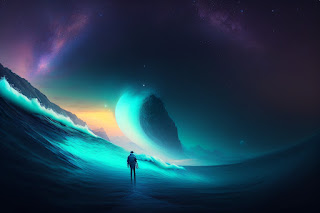Exploring the Interplay of Universes in the Multiverse -
The Dance of Galaxies: Exploring the Interplay of Universes in the Multiverse -
Introduction:
The mysteries of the cosmos have captivated humanity for millennia. From ancient myths to modern scientific inquiry, we have sought to understand the vastness of the universe and our place within it. As our knowledge has expanded, so too has our exploration of the possibility of a multiverse—a realm where multiple universes exist, each with its own set of physical laws and conditions. In this blog, we embark on a journey into the fascinating concept of the multiverse and explore the interplay of galaxies within its vast cosmic tapestry.
Defining the Multiverse:
The concept of the multiverse suggests that our universe is just one of many, coexisting alongside an ensemble of other universes. Each universe within the multiverse may have its own distinct properties, such as different physical constants, varying laws of physics, or even alternate histories. The idea of a multiverse has gained traction within the realm of theoretical physics, offering a potential solution to various cosmological puzzles and providing a framework for understanding our own universe's remarkable properties.
Cosmic Inflation and the Multiverse:
One of the key drivers behind the multiverse theory is the concept of cosmic inflation. According to the inflationary model proposed by physicist Alan Guth, the universe experienced a rapid expansion phase in its early moments. This cosmic inflationary period could have caused the universe to rapidly duplicate and create "bubble" universes within the greater multiverse. These bubble universes would then expand and develop their own unique characteristics, potentially giving rise to an infinite array of parallel universes.
Galaxies as Cosmic Islands:
Within each universe, galaxies serve as celestial islands, housing billions of stars, planets, and other celestial objects. The formation and evolution of galaxies play a vital role in shaping the vast cosmic tapestry of the multiverse. Through the interplay of gravitational forces, collisions, and mergers, galaxies constantly interact and reshape their environments, giving birth to new stars and even triggering the formation of other galaxies.
Galactic Collisions and Mergers:
Galactic collisions and mergers are dramatic events that occur when two or more galaxies come into close proximity and their gravitational forces interact. These cosmic dances can lead to the merging of galaxies, forming larger, more massive structures. As galaxies collide, stars rarely collide directly due to the vast distances between them. However, the gravitational forces at play can cause distortions in the shape of galaxies and trigger bursts of star formation. Over time, the merging galaxies settle into a new equilibrium, creating stunning cosmic vistas.
Supermassive Black Holes and Galactic Evolution:
At the heart of most galaxies, including our own Milky Way, lies a supermassive black hole. These behemoths exert an immense gravitational pull, shaping the evolution of their host galaxies. During galactic collisions, supermassive black holes can also merge, resulting in an even more massive black hole. These events release colossal amounts of energy in the form of gravitational waves and can profoundly influence the structures and dynamics of galaxies in the multiverse.
The Great Attractor: A Cosmic Choreographer:
In the cosmic dance of galaxies, there exists a mysterious gravitational anomaly known as the Great Attractor. This enigmatic force, located in the direction of the Centaurus and Hydra constellations, acts as a cosmic choreographer, influencing the motion of galaxies within its vicinity. While the exact nature of the Great Attractor remains a subject of ongoing research, it highlights the intricate interplay between galaxies on a grand scale and serves as a reminder of the vastness and complexity of the multiverse.
Parallel Universes and the Multiverse:
As we contemplate the dance of galaxies within the multiverse, the concept of parallel universes emerges.
Parallel universes exist alongside our
own, possibly governed by different physical laws or hosting variations of reality. These parallel universes may have their own galaxies and cosmic dances, each unfolding in its unique way. The exploration of parallel universes within the multiverse holds the potential to expand our understanding of the cosmos and challenge our perception of reality.
Conclusion:
The dance of galaxies within the multiverse represents a mesmerizing interplay of cosmic forces, shaping the fabric of our existence. As we continue to unravel the mysteries of the multiverse, we gain insight into the profound interconnectedness of galaxies and their influence on the wider cosmic stage. The concept of the multiverse invites us to imagine a vast ensemble of universes, each with its own dance of galaxies, expanding our understanding of the cosmos and our place within it. The exploration of the multiverse awaits, promising discoveries that may reshape our perception of reality and unveil the wonders of the cosmic tapestry that stretches beyond the limits of our universe...
-Keva



Amazing work!
ReplyDeleteHi Keva... I m Kriti from West Bengal... Simple but unique... I like simple blogs like u have created, Luv u from West Bengal
ReplyDeleteThank you Kriti for your support and time you gave! I am glad to hear that you like my blog!
Delete